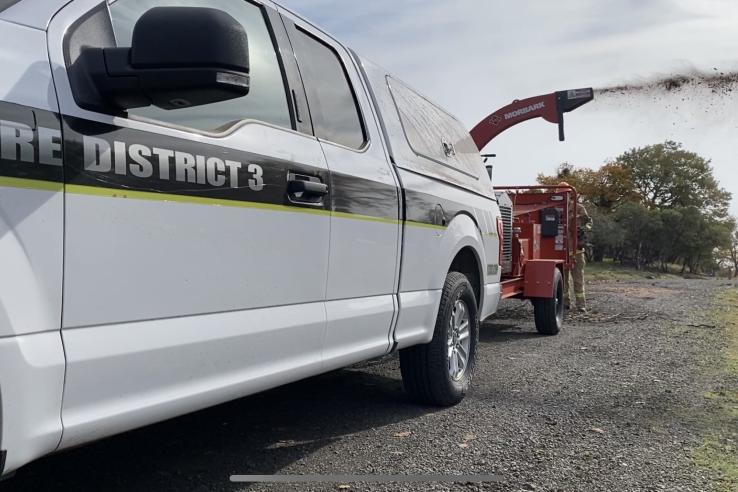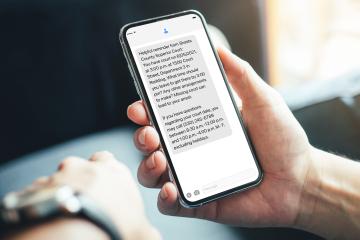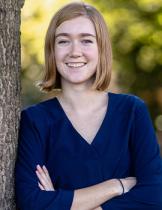
Building research partnerships to address wildfire risk in Jackson County, Oregon

In 2021, Bob Horton was serving as a fire chief in Oregon’s Jackson County. Their district had just lived through the 2020 Almeda fire, which destroyed 2,600 homes and was the most destructive wildfire in Oregon’s recorded history. As community members came together to rebuild, Bob Horton strategized how to better equip households to be resilient to wildfire and prevent future catastrophes. He turned to research to inform his decision-making and reached out to J-PAL North America for support.
Through J-PAL North America’s Evaluation Incubator for state and local government agencies, Bob attended J-PAL’s evaluating social programs course, received funding, technical assistance from J-PAL staff, and connections to researchers in the J-PAL network. With the help of this support, Bob and his research partners Judson Boomhower (University of California, San Diego) and Patrick Baylis (University of British Columbia) received funding for a randomized evaluation and research management support (RMS) from J-PAL to evaluate a program encouraging households to take-up wildfire prevention practices. We spoke with Bob Horton, Judson Boomhower, and Patrick Baylis to learn more about their partnership.
Bob, why was Jackson County Fire District 3 interested in evaluating an intervention to reduce wildfire risk in Oregon?
We spend a lot of money on mitigating wildfire risk—both as a fire district and as a nation. I wanted to make sure our investments were strategic and meaningful. I was confident that entering into a project with rigorous evaluation would ensure this was the case. Todd Pugatch, a professor of mine at Oregon State University and researcher in J-PAL’s network, knew I was interested in wildfire risk and that I worked in local government. He connected me to J-PAL North America’s Evaluation Incubator opportunity that he had learned about through a newsletter.
We had a lot of encouragement, excitement, and enthusiasm around growing our fire district’s capacity for evaluation through partnership with J-PAL. We simply don’t have the administrative capacity, knowledge, skills, and abilities to do something like this on our own, which is a shame. I think local government and special districts should have teams to do these kinds of evaluations, but we don't, so we're grateful that J-PAL offers support.
Judd and Patrick, what drew you to take on this project as academic economists?
It was immediately clear that this was a great opportunity. We would have the chance to work with expert practitioners who were committed to careful evaluation, and we would get to shed light on first-order economic and policy questions around adaptation to growing climate risk. It was great to have J-PAL building the bridge between us as academic researchers and Chief Horton and Jackson County Fire District 3 as practitioners.
Bob, what was needed to design the intervention and prepare for evaluation?
I didn’t have a good idea of how much work it is to go from an evaluation concept to implementation. A lot of our time was spent thinking about what was actually feasible. We could dream about all these different designs or interventions we would want to do, but at the end of the day, they needed to be ideas that we could practically implement.
I was at an advantage because I was the chief executive of the Fire District and the board of directors I reported to, and my team supported this work. My team probably didn't like all the unusual ideas I brought forward, however, we found ways to get what we needed done. Getting buy-in from higher-ups or other other partners can become a barrier. In our case, this project was entirely within the scope of our fire district and we had resources invested in wildfire risk reduction already, which made moving this work forward a lot easier.
What role did J-PAL’s technical assistance and research management support play?
Bob: J-PAL’s support was just flat instrumental—it was as if the staff on our project were part of our organization. It was like instantaneous capacity growth.
The staff took the time to understand our community, our organization, and the risks for this work to go sideways. They encouraged us to think about all of that ahead of time, before we got to the actual intervention design. Because we don’t have experience running evaluations at a large scale, we simply needed the thought partnership that J-PAL provided. Then, when Judd and Patrick came in, they helped us to think about what had been done in similar projects. In partnership with them, we refined, refined, and refined, until we ultimately had interventions to test.
The partnership we’ve had with Judd and Patrick has been incredible. I was unsure at the front end that any researchers would even want to be a part of something like this. J-PAL connected us with two absolute gems for this kind of work. They’ve been very understanding and were willing to open up our partnership for a qualitative researcher at Oregon State University to also help us. Throughout it all, nothing got in the way of putting the members of our community first.
Judd and Patrick: Designing and implementing a field experiment is a big lift. It involved developing outreach materials, securing appropriate research approvals, and building working relationships with our partners in Oregon. J-PAL's RMS team was instrumental in helping us make continuous forward progress on all of these fronts. Their support was also essential for helping us think clearly about the tradeoffs between what is possible and what would be perfect (for example, by setting up meeting agendas, taking notes, and generally keeping us focused on key objectives). It also expanded the scope of the possible by helping us overcome challenges to implementation (for example, experimenting with other mailer designs to increase participation).
Finally, working alongside Bob and his team has been a real pleasure. Their deep understanding of the Jackson County District 3 community and the wildfire risk challenges they face has helped sharpen our thinking about the broader key economic tradeoffs rooted in public policy-making around natural disaster risk. We are extremely grateful to J-PAL and the RMS team for making such a great partnership possible.
Where do you see this work going from here?
Judd and Patrick: We are really excited about what we are learning in the current pilot experiment. We have already had lots of good conversations with our fire district partners about follow-up questions and ideas. Stay tuned!
Bob: We’re excited to think about how to scale up and look more broadly than Jackson County. Many states and counties are learning that they’re more wildfire prone than they thought. Many more are learning that in the next thirty years they will become wildfire prone as a result of changing climates. With this in mind, answering these questions is critical to build a knowledge base focused on promoting communities resilient to wildfire. We hope that putting more evaluation and evidence behind these questions will help us learn more about how we can be prepared.
This piece is the seventh in an ongoing series highlighting research partnerships with state and local governments fostered through J-PAL North America’s Evaluation Incubator. The fifth & sixth pieces feature New York City’s evaluation of their summer youth employment program.
Related Content

Building research partnerships to address the opioid crisis in Minnesota, part two

Building research partnerships to address failures to appear for court in Shasta County, part one


